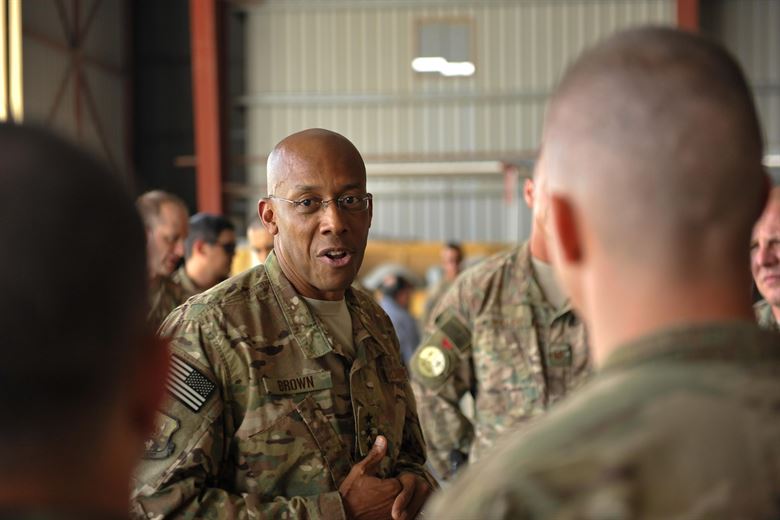
Gen. Charles Brown
WASHINGTON: The nominee to replace outgoing Air Force Chief of Staff Gen. David Goldfein, Gen. Charles Brown, is expected to continue to be a strong advocate for Goldfein’s vision of all domain command and control to link all sensors to all shooters across the military services.
Brown currently is in charge of Pacific air forces. A number of Air Force watchers say he has been the ‘heir apparent’ to Goldfein for a number of months. He was nominated by President Donald Trump for the job this afternoon. Brown will be the first African American to serve as a service chief.
“He’s coming from a location that is up close and personal,” said Dave Deptula, dean of the Mitchell Institute for Aerospace Studies, referencing what Pentagon leaders characterize as an ever-growing threat from Chinese activities in the region. “So he is a perfect fit in that regard.” That, is of course, reference to the National Defense Strategy’s identification of China as America’s major long-term competitor.
Leading the Air Force “is important, yet difficult work that will only grow more complicated as the security environment continuously changes in this era of Great Power Competition,” DoD Secretary Mark Esper said in a statement this afternoon. “With Gen. CQ Brown’s nomination, comes the right level of talent and experience for the job to hone Airman lethality and readiness; strengthen bonds with allied and partner air forces, and to do this efficiently.”
As Breaking D readers know, Goldfein’s top priority for the past two years has been conceiving and building all-domain connectivity, the centerpiece of which for the entire military is what is now called Joint All Domain Command and Control (JADC2). The Air Force has been given the lead by Chairman of the Joint Chiefs of Staff Mark Milley in trying to make that concept a reality via technology development, under the Advanced Battle Management System program.
In a breakfast with the Defense Writers Group in December, Brown said that he already has been working with staff at Pacific Air Command to figure out how to overcome what he expects to be a severely reduced communications environment in any future conflict with China or Russia. This includes figuring out whether a multi-day air tasking order could be written in advance so officers in the field are aware of what is expected even when communications drop out.
But the biggest barrier to achieving JADC2, he said, is cultural. “It’s a different thought process,” he said. It will require turning the current C2 processes for communications on the battlefield on its head, he explained.
“In the military we have a term called a PACE Plan for Communication, Primary Alternate Contingency and Emergency. I actually don’t believe in that now,” he said. Instead, he elaborated, “Our contingency or emergency plan would be that we’re fully connected. If we’re fully connected we ought to be surprised and suspect, suspect that we’re being spoofed.”
Brown has headed up Pacific Air Forces since July 2018. Prior to that he spent two years as deputy commander of Central Command.
“CQ Brown is one of the finest warriors our Air Force has ever produced. He’s led worldwide – in the Pacific, Europe, the Middle East and Africa,” Goldfein said in the Air Force’s press release. “When it comes to global, operational savvy there’s nobody stronger.
Most importantly to many of our readers, he also has Washington experience — something that is essential for service chiefs especially in these politically fraught days. He was aide-de-camp to Air Force Chief of Staff Gen. Ronald Fogleman from October 1994-July 1996, and was a National Defense Fellow with the Institute for Defense Analyses from July 2003-June 2004.
“He’s got a good amount of DC experience, and … from the right perspectives,” Deptula said. In particular, working with Fogleman would have given Brown insights into the kinds of issues that face senior service leaders.






















